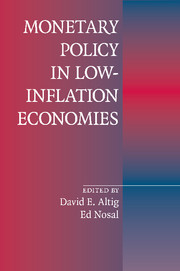Book contents
- Frontmatter
- Contents
- Contributors
- Acknowledgments
- Introduction
- 1 The Welfare Cost of Inflation in the Presence of Inside Money
- Commentary
- 2 An Open-Economy Model of Endogenous Price Flexibility
- Commentary
- 3 Efficient Inflation Targets for Distorted Dynamic Economies
- Commentary
- 4 Inflation and Welfare in Models with Trading Frictions
- Commentary
- 5 Good versus Bad Deflation: Lessons from the Gold Standard Era
- Commentary
- 6 Monetary Policy Orientation in Times of Low Inflation
- Commentary
- 7 Observations on Disinflation in Transition Economies
- Commentary
- 8 Inflation and Financial Market Performance: What Have We Learned in the Last Ten Years?
- Commentary
- Index
8 - Inflation and Financial Market Performance: What Have We Learned in the Last Ten Years?
Published online by Cambridge University Press: 26 January 2010
- Frontmatter
- Contents
- Contributors
- Acknowledgments
- Introduction
- 1 The Welfare Cost of Inflation in the Presence of Inside Money
- Commentary
- 2 An Open-Economy Model of Endogenous Price Flexibility
- Commentary
- 3 Efficient Inflation Targets for Distorted Dynamic Economies
- Commentary
- 4 Inflation and Welfare in Models with Trading Frictions
- Commentary
- 5 Good versus Bad Deflation: Lessons from the Gold Standard Era
- Commentary
- 6 Monetary Policy Orientation in Times of Low Inflation
- Commentary
- 7 Observations on Disinflation in Transition Economies
- Commentary
- 8 Inflation and Financial Market Performance: What Have We Learned in the Last Ten Years?
- Commentary
- Index
Summary
INTRODUCTION
This study investigates the relationship between inflation and financial market performance. Largely, our objective is to review the extensive literature that has grown up on this topic over the last ten years or so, through the end of 2003.We also provide a few new empirical findings, primarily on the association between inflation and interest rates and between inflation and bank profits. Our review of the theory is relatively brief, compared to what it could be. This is not because the theory literature is small or unimportant but because an excellent review piece was written by our friend and colleague Bruce D. Smith just before his untimely death in 2002.
Why the recent interest in inflation and financial markets? The empirical finding of a negative association between inflation and real economic growth (e.g., Barro 1995) generated enormous interest and much subsequent work. An obviously important issue was to determine whether this association really exists and, after that had been done, to try to explain why. Another important empirical finding at about the same time was that financial intermediaries (banks and markets) seem to play a key role in economic development (King and Levine 1993a, 1993b; Levine and Zervos 1998). This finding, too, generated a great deal of subsequent interest and follow-up research. The obvious link between the two findings is the possibility that inflation might be affecting real growth through the financial markets—specifically, by damaging financial markets or impeding their operation. Several of the theoretical models that we discuss in the following section allow for this possibility, and much of the empirical work reviewed or presented later looks for evidence of such effects.
- Type
- Chapter
- Information
- Monetary Policy in Low-Inflation Economies , pp. 259 - 301Publisher: Cambridge University PressPrint publication year: 2009



